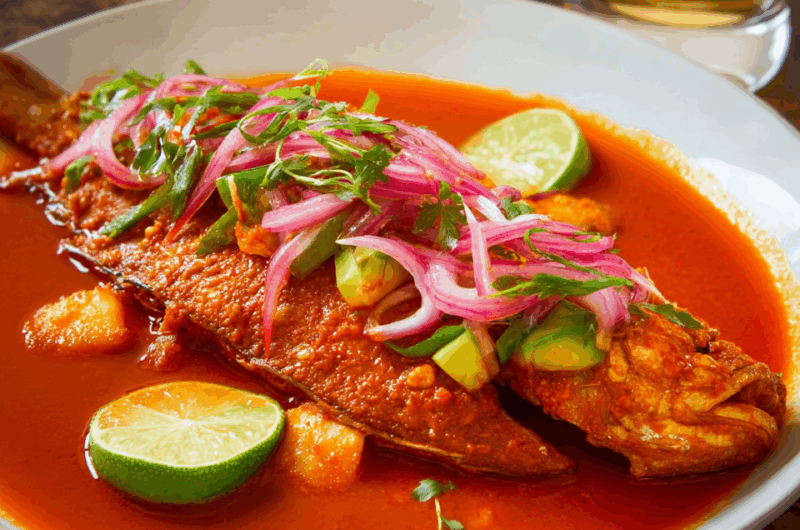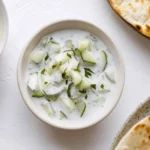This Yucatán-inspired dish is all about bold, aromatic flavors that celebrate Mexican culinary traditions. The achiote paste, with its earthy annatto seeds, blends perfectly with citrus juices, garlic, and warm spices to create a marinade that infuses the fish with color and taste. Wrapping the fish in banana leaves before baking not only locks in moisture but also imparts a subtle, herbaceous fragrance that makes every bite irresistible.
Pescado en Achiote is more than just a meal—it’s a sensory experience. From the deep red hue of the marinade to the steam that escapes as you unwrap the banana leaves, this dish feels like a festive occasion at the table. Whether paired with fluffy rice, warm tortillas, or a crisp salad, it brings the flavors of the Yucatán straight to your kitchen with minimal effort but maximum reward.
Full Recipe:
-
2 pounds white fish fillets (snapper, grouper, or cod)
-
1/4 cup achiote paste
-
1/4 cup orange juice (fresh preferred)
-
2 tablespoons lime juice
-
3 cloves garlic, minced
-
1 tablespoon olive oil
-
1 teaspoon dried oregano
-
1/2 teaspoon ground cumin
-
1 teaspoon salt
-
1/2 teaspoon black pepper
-
1 red onion, thinly sliced
-
Banana leaves or parchment paper (for wrapping, optional)
-
Fresh cilantro and lime wedges for garnish
Directions:
-
In a bowl, combine achiote paste, orange juice, lime juice, garlic, olive oil, oregano, cumin, salt, and pepper. Mix well until smooth.
-
Place fish fillets in a shallow dish and coat with the marinade. Cover and refrigerate for at least 1 hour.
-
Preheat oven to 375°F (190°C).
-
If using banana leaves, briefly pass them over a flame or hot pan to soften. Wrap each marinated fish fillet with some onion slices inside banana leaves (or parchment paper). Secure tightly.
-
Arrange wrapped fish packets on a baking sheet and bake for 25–30 minutes, until the fish flakes easily with a fork.
-
Carefully unwrap, garnish with fresh cilantro and lime wedges, and serve with rice or warm tortillas.
Prep Time: 15 minutes | Marinate Time: 1 hour | Cooking Time: 30 minutes | Total Time: 1 hour 45 minutes
Kcal: ~280 kcal per serving | Servings: 4 servings
Origins of Pescado en Achiote
Pescado en Achiote, or Mexican Fish in Annatto Sauce, is one of the most iconic dishes of the Yucatán Peninsula. This region of Mexico is known for its deep connection to Mayan traditions, and food plays a central role in preserving that heritage. Achiote paste, the key ingredient in this dish, is made from annatto seeds, which have been used for centuries not only for culinary purposes but also for rituals, medicine, and natural dyeing. When combined with citrus juices, spices, and garlic, achiote transforms into a vibrant marinade that gives fish a striking red hue and a depth of flavor unique to Yucatán cuisine.
The tradition of wrapping fish in banana leaves before cooking is also rooted in Mayan culture. This method helped seal in moisture and infuse the fish with a subtle, earthy aroma from the leaves. Today, Pescado en Achiote remains a dish that embodies both history and culinary artistry, often prepared for family gatherings, festivals, and special occasions.
The Role of Achiote in Mexican Cuisine
Achiote paste is the soul of this dish. Made primarily from annatto seeds, it has a mild, slightly peppery flavor with earthy undertones. While achiote itself is not spicy, it pairs beautifully with chili peppers, citrus, and herbs, creating layers of taste that are bold yet balanced. In Mexican cooking, achiote is used in a variety of dishes beyond fish—such as cochinita pibil, grilled meats, and even rice preparations.
For Pescado en Achiote, the paste is blended with orange and lime juice, garlic, and spices. The acidity of the citrus tenderizes the fish while cutting through the richness of the marinade, resulting in a dish that is light, fragrant, and refreshing. The brilliant red color imparted by annatto seeds also gives the dish its signature look, making it visually striking on the dining table.
Flavor Profile of Pescado en Achiote
The flavor of this dish is a harmonious balance of citrusy brightness, earthy undertones, and gentle smokiness. Unlike heavier sauces or marinades, achiote has a freshness that enhances rather than masks the natural taste of the fish. The citrus juices lend tanginess, while garlic and spices create depth. When baked or grilled, the fish develops a delicate flakiness that absorbs all the complex notes of the marinade.
Banana leaves, if used, add another dimension. When heated, they release subtle herbal aromas that infuse the fish. While parchment paper can be substituted, banana leaves remain the traditional choice, making the experience more authentic and elevating the presentation. Each bite of Pescado en Achiote feels like a celebration of flavor, culture, and nature combined.
Health Benefits of the Dish
Beyond its flavor, Pescado en Achiote is also a nutritious choice. White fish, commonly used for this recipe, is high in lean protein, low in fat, and rich in essential nutrients such as omega-3 fatty acids, vitamin B12, and selenium. These nutrients contribute to heart health, brain function, and overall vitality.
Achiote itself, derived from annatto seeds, contains antioxidants and carotenoids that may help reduce inflammation and support eye health. Combined with the vitamin C found in fresh citrus juice, the marinade becomes both delicious and beneficial. This makes the dish an excellent option for those who want to enjoy a flavorful meal while still prioritizing wellness.
Traditional Serving Ideas
Pescado en Achiote is traditionally served with white rice or warm corn tortillas. The rice acts as a neutral base that soaks up the vibrant marinade, while tortillas allow diners to create their own handheld portions, often topped with fresh salsa or pickled red onions. In the Yucatán, it’s not uncommon to find this dish paired with black beans, avocado slices, and tangy habanero salsa.
The bright colors of the dish also make it a showstopper at festive meals. A platter of Pescado en Achiote, garnished with fresh cilantro and lime wedges, brings warmth and authenticity to the table. Whether served family-style or as individual portions, it always leaves a lasting impression on guests.
Modern Adaptations of the Classic
While the traditional preparation remains beloved, modern cooks have found creative ways to adapt Pescado en Achiote. Some chefs prepare it on the grill instead of baking, allowing the fish to absorb a smoky char that enhances the earthy notes of the marinade. Others experiment with different types of seafood such as shrimp, scallops, or salmon, proving that achiote’s versatility extends beyond white fish.
In urban kitchens where banana leaves are harder to find, parchment paper or foil works just as well to keep the fish moist. Restaurants may also serve the fish atop fresh salads or with roasted vegetables, catering to diners who prefer lighter, low-carb options. These adaptations ensure that the spirit of the dish lives on while meeting the needs of contemporary lifestyles.
Cultural Significance and Storytelling Through Food
What makes Pescado en Achiote truly special is its ability to tell a story. Each bite connects diners to the history of the Mayan people, the land where annatto seeds are cultivated, and the traditions passed down through generations. Food in Mexico is never just about sustenance—it is about family, memory, and celebration.
Sharing this dish with loved ones is a way of honoring cultural heritage while creating new traditions at the same time. For many, cooking Pescado en Achiote at home is a way of experiencing Yucatán’s culinary richness without having to travel. It bridges the gap between the past and present, reminding us that food is one of the most powerful forms of storytelling.
Perfect Occasions to Enjoy the Dish
This vibrant fish dish is versatile enough to be enjoyed in many settings. It works beautifully as a centerpiece for a weeknight family dinner, offering both nutrition and flavor without being overly complicated. At the same time, it shines at festive gatherings, where its bold colors and aromas capture the attention of guests.
Summer barbecues, cultural celebrations, or even casual weekend get-togethers are all perfect opportunities to prepare Pescado en Achiote. Because the dish is naturally gluten-free and adaptable to various diets, it is also inclusive, allowing everyone at the table to indulge without worry.
Conclusion
Pescado en Achiote is more than a recipe—it is an expression of Mexican culture, history, and flavor. With its origins in Mayan traditions, its use of annatto seeds and banana leaves, and its balance of citrus and spices, it is a dish that captures the essence of the Yucatán Peninsula. The marinade not only creates an unforgettable taste but also reflects the ingenuity of combining local ingredients to craft something extraordinary.
Whether prepared in its most traditional form or adapted for modern kitchens, Pescado en Achiote continues to delight food lovers around the world. It stands as proof that food can connect us to heritage, bring families together, and elevate everyday meals into memorable experiences. Adding this dish to your repertoire means embracing centuries of culinary wisdom and sharing a piece of Mexico’s vibrant story on your plate.








